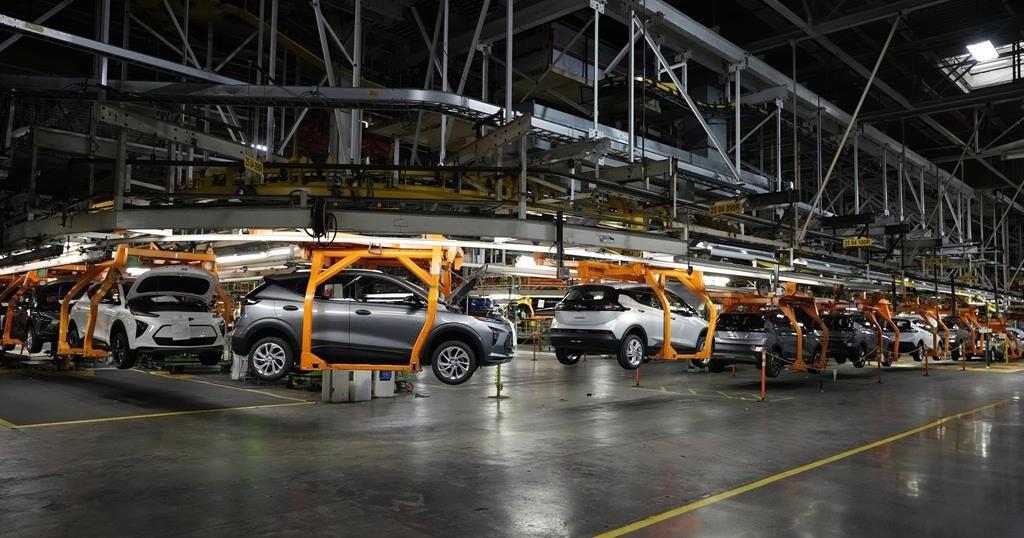The potential of tariffs on Chinese electric vehicle imports is being welcomed by the Canadian head of General Motors as major producer BYD looks to enter the market.
“We’re encouraged by the government’s examination of these issues,” said Kristian Aquilina, president of GM Canada.
“Because on the basis of strong competition, a fair playing field, it encourages us to invest heavily, employ deeply.”
The federal government wrapped a 30-day consultation last week on whether to follow the lead of the U.S. and the European Union on imposing steep tariffs to counter the volume of production coming out of China.
Canada’s auto sector faces “unfair competition” from China’s state-directed policy of overcapacity and broad range of non-market policies and practices, the federal government said in announcing the consultations.
Without directly calling out Chinese producers, Aquilina noted similar concerns.
“An unfair playing field can be quite detrimental, and it’s only right that the government look at these issues and consider all of the facts,” he said.
He deferred to the Canadian Vehicle Manufacturers’ Association for more specific commentary on the tariffs. The group has pushed strongly for alignment with U.S. policy so that the more than $40 billion in Canadian EV industry investments announced over the past four years can have room to succeed.
“This transition is happening, but it does take time, and we have to make sure that adequate supports are in place to allow these investments, and these new facilities to come online,” said president Brian Kingston.
Aligning with the U.S. would also send the right signals ahead of North American trade talks scheduled for 2026, said Kingston.
“Now is the time. Let’s put these policies in place, show the American people we are going to stand shoulder to shoulder with them in this approach to China.”
Groups like Unifor, the Global Automakers of Canada and the Canadian Chamber of Commerce have also expressed support, while climate-focused associations like Clean Energy Canada have pushed back over concerns the move would cut off more affordable options for electric vehicles.
The potential tariffs could be substantial. In May, the U.S. boosted its tariffs to 100 per cent from 25 per cent, while the EU has set tariffs that could run upwards of 38 per cent.
For now, the only Chinese-made EVs imported into Canada are from U.S. tech giant Tesla, made at the company’s Shanghai factory, which are subject to a six-per-cent import tariff.
There is, however, the potential for China-based BYD, the world’s biggest electric vehicle producer by volume, to come to Canada.
A July 24 lobbyist registration showed the company had hired a consultant to advise on “matters related to the expected market entry of BYD into Canada,” and the application of tariffs on EVs.
BYD, which phased out gasoline-only models in 2022, sold over three million vehicles last year. The company debuted its Seagull EV last year at a starting price of the equivalent of about $14,600 for a 305-kilometre range version.
General Motors, meanwhile, discontinued its entry-level Chevy Bolt EV last year, only to clarify it planned to later relaunch the model.
Timing of a return, and potential pricing, of the Bolt is still not fixed, but the company is aiming to bring it back late next year, said Aquilina.
For now, the company is focused on rolling out its newly arrived Chevy Equinox EV, retailing for around $50,000, which he said puts GM with the most affordable EV in Canada that has around 500 kilometres of range.
While the price range is still out of reach for many, it also reflects rising prices generally for cars.
The average price for a new vehicle in Canada was about $68,000 for June, up from $55,000 two years ago, according to AutoTrader. Meanwhile, Canadian Black Book says the average price of an EV topped $73,000 last year.
The push higher in EV prices came as producers made bigger vehicles with bigger batteries that made for greater range (and potential profits), but GM says it sees customers’ appetites to give up some of that range.
“At the outset when range anxiety was at its highest, that became the thing that customers wanted more than anything else,” said Aquilina.
“What the Bolt has proven … is that customers are willing to make that trade-off between range and price because, of course, there is a relationship and that’s really given us encouragement to reintroduce the Bolt.”
The debate around pricing and tariffs come as EV sales are pulling back and producers rein in expectations and ambitions on the transition.
In late July, Umicore announced it had halted spending on a $2.76-billion battery materials plant in eastern Ontario, citing substantially scaled-back growth projections for the EV market.
And in April, Ford pushed back planned EV production at its plant in Oakville, Ont., by two years, only to annonuce in June it was switching production plans away from EVs to its Super Duty pickup trucks.
Meanwhile, zero-emission vehicles, which include pure battery and plug-in hybrids, made up 11.3 per cent of all auto registrations in the first quarter, down from 12 per cent in the quarter before, said Statistics Canada, while U.S. growth is slowing even more.
Despite a slight pullback, battery electric vehicle registrations were still up 57 per cent in the first four months of 2024 compared with last year, while plug-in hybrids were up more than 75 per cent, according to S&P Global Mobility.
What the gains and pullbacks show are that the transition won’t be a straight line, said Aquilina.
“What GM has learned is the need to be flexible, and adaptable, because change is something that will have its ups and downs.”
This report by The Canadian Press was first published Aug. 6, 2024.

























